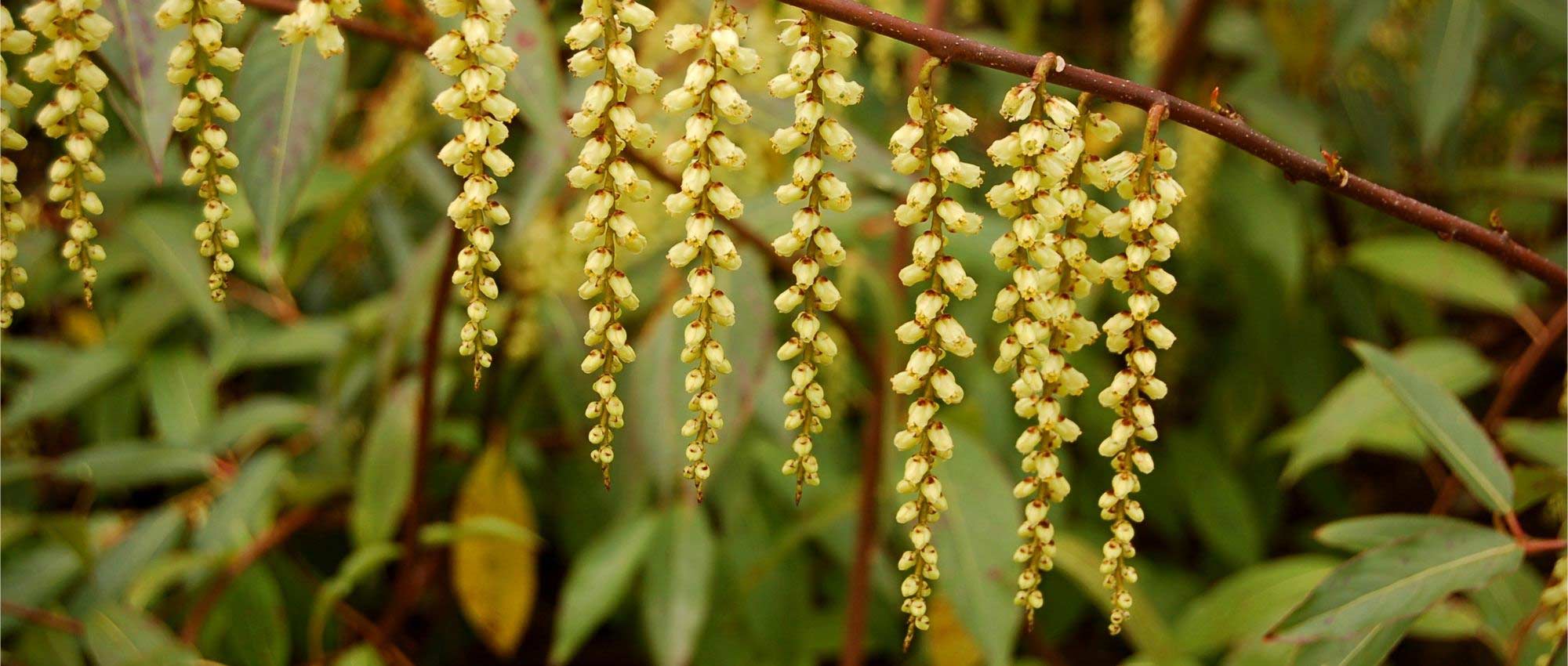
Stachyurus: planting, growing, and care
Contents
Stachyurus in a nutshell
- Stachyurus is a beautiful Asian shrub, still too rarely grown
- It is among the first bushes to flower, as early as the end of winter!
- It bears long, pendulous clusters, very graphic, in a cream-yellow colour
- Its foliage takes on beautiful autumn colours!
- Easy to grow, it shoots up quickly, is hardy, and not very susceptible to diseases
A word from our Expert
Stachyurus is a rare and original shrub from Asia that offers a very graphic flowering at the end of winter. It bears long pendulous clusters made up of small bell-shaped flowers, in a yellow cream – light green colour. Stachyurus also has beautiful foliage that turns red, yellow, or orange in autumn before falling. The most commonly grown are Stachyurus praecox and Stachyurus chinensis, particularly the varieties ‘Celina’, which has a compact habit and very abundant flowering, and ‘Joy Forever’, which offers superb variegated yellow foliage.
Stachyurus is an easy bush to grow, with no particular concerns. It is not susceptible to diseases or pests and requires little attention. In the garden, plant it in partial shade or in non-burning sunlight, in rather acidic or neutral soil as it does not appreciate lime. The soil should ideally be fertile, light, and humus-bearing. Stachyurus does not like cold winds; therefore, it should be placed in a sheltered spot. It is perfect against a wall, to highlight its original, airy habit as well as its flowering. Its fine, flexible branches can also be trained, for example, by guiding them over an arch.
Botany
Botanical data
- Latin name Stachyurus sp.
- Family Stachyuraceae
- Common name Stachyurus
- Flowering late winter, February-March
- Height between 3 and 4 m
- Exposure sun or partial shade
- Soil type cool, draining, fertile, light, non-calcareous
- Hardiness between -15 and -20 °C
Stachyurus comprises 7 species of shrubs or small trees from temperate climates, native to East Asia (Himalayas, China, Japan…). Most cultivated species are deciduous, but a few are evergreen. In the wild, Stachyurus grows in underbrush and thickets, often at the forest edge. Stachyurus chinensis and S. salicifolius are from China, while Stachyurus praecox hails from Japan and the Himalayas. The latter was discovered in Japan by the German naturalist Philipp Franz von Siebold, who introduced many Japanese plants to Europe. Stachyurus also grows in mountainous regions: S. chinensis can be found up to 3,000 metres in altitude.
Stachyurus are uncommon shrubs in gardens; they are not very well known or cultivated. However, they possess beautiful ornamental qualities, grow quickly, and are relatively disease-resistant. Moreover, they are quite hardy, tolerating temperatures between -15 and -20°C. Their flower buds can, however, be damaged by frost, which is why they should preferably be planted in a sheltered spot away from cold winds.
Etymologically, the name Stachyurus comes from the Greek Stachys: spike, and oura: tail, referring to the shape of its inflorescences. The species name chinensis reminds us of its Chinese origin, while praecox refers to its early flowering.
Stachyurus has given its name to the family Stachyuraceae. In fact, it is the only genus in this family! Stachyurus was previously classified in the family Hamamelidaceae.

The inflorescences and details of the flowers of Stachyurus praecox (photos Σ64, Salicyna and William Friedman)
Stachyurus are shrubs with a very airy silhouette, consisting of long, slender branches, arching and very elongated. They typically reach heights of 2 to 3 metres, and can grow up to 4 m at most. Their branches are glossy and have a beautiful mahogany colour, turning purplish brown over time. They are long, flexible, and arching, giving the shrub a semi-climbing habit. For example, it can be trained against a wall or along an archway.
The flowering of Stachyurus occurs before the leaves appear, usually in February-March (sometimes until April, depending on the varieties). Thus, its flowering heralds the end of winter and the return of fine weather! The shrub bears long, pendulous inflorescences, in fine clusters, measuring between 5 and 13 cm long. They resemble catkins, like those of the hazel. The inflorescences of Stachyurus consist of small bell-shaped flowers, with four petals, in a creamy yellow – light green colour, borne on a purplish stem. The incredible graphic quality of its flowering is much appreciated! The variety ‘Rubriflora’, on the other hand, is distinguished by its red-pink flowers, which is quite rare among Stachyurus.
Stachyurus praecox and S. chinensis can be confused, but the clusters are shorter and the flowers larger in S. praecox.
The inflorescences appear on the bare branches, making them very visible. There are no leaves to hide them! This is a rather bright flowering, which enlivens the garden at a time when flowers are still rare! Moreover, the flowering is appreciated by pollinating insects, particularly bees, at a time when there are still few plants in bloom.
After flowering, Stachyurus produces globular berries that are pale yellow – green, turning red when ripe.

The fruits of Stachyurus praecox
The leaves of Stachyurus are entire, generally oval or lanceolate in shape, with a dentate margin. They are inserted alternately on the stems (one leaf after another). The leaves typically measure 10 to 15 cm long. The Stachyurus salicifolius has stunning long, slender leaves reminiscent of those of the willow! This is indeed what its species name means, salicifolius = “willow-leaved (Salix)”.
Some varieties are distinguished by their colourful foliage, such as Stachyurus ‘Joy Forever’, with variegated yellow leaves, or Stachyurus praecox ‘Sterling Silver’, with stunning silver foliage edged in white. These shrubs are perfect for bringing brightness to a shady corner!

The leaves of Stachyurus praecox (photo Σ64), Stachyurus ‘Joy Forever’ and Stachyurus salicifolius (photo Paco Garin)
There are evergreen species, such as Stachyurus salicifolius or S. obovatus, which retain their leaves in winter, but the most common species in gardens, such as S. chinensis and S. praecox, are deciduous: their leaves take on beautiful autumn colours, usually yellow, orange, or red, before falling, and reappearing in spring after flowering.

The foliage of Stachyurus takes on beautiful autumn colours! Stachyurus praecox (photo Leonora Enking) and Stachyurus chinensis ‘Celina’ (photo peganum)
The main varieties of Stachyurus
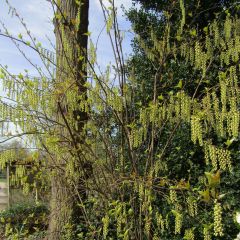
Stachyurus chinensis Celina
- Flowering time April, May
- Height at maturity 3 m
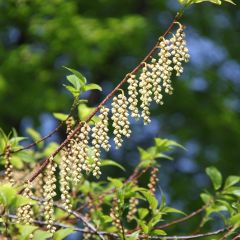
Stachyurus praecox
- Flowering time March, April
- Height at maturity 3 m
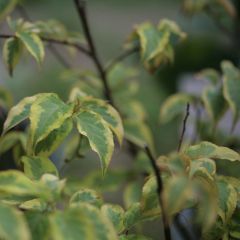
Stachyurus chinensis Joy Forever
- Flowering time March, April
- Height at maturity 2 m
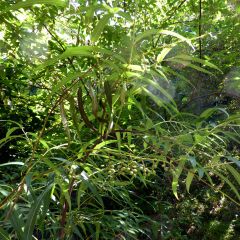
Stachyurus salicifolius
- Flowering time April, May
- Height at maturity 2,50 m
Discover other Stachyurus
View all →Available in 1 sizes
Available in 2 sizes
Available in 2 sizes
Available in 1 sizes
Available in 1 sizes
Available in 1 sizes
Planting
Where to plant?
In nature, Stachyurus primarily grows at the edge of woodlands, so it prefers partial shade but can also tolerate non-burning sunlight. It is quite tolerant regarding exposure, but it flowers less well in dense shade (whereas a bright location encourages its flowering). Ideally, plant it sheltered from cold, drying winds. The soil should be well-draining but remain relatively cool in summer. Stachyurus enjoys fertile, humus-bearing, fairly light soils. At the time of planting, we recommend adding well-decomposed compost, heather soil, and coarse sand or gravel to improve drainage. Stachyurus is considered an acidophilous plant; however, while it is true that they prefer acidic soils, they will also grow in neutral or slightly calcareous soil.
You can plant Stachyurus as a solitary specimen to highlight its architecture, in a mass planting, or in groups of 3 to 5 shrubs. Stachyurus also adapts well to pot culture, but choose a sufficiently large container.
Stachyurus is perfect for dressing a wall. In addition to showcasing it, this will provide a sheltered location, where it will be somewhat more protected from wind and cold. Stachyurus is also a plant that can be easily trained: it has a semi-climbing habit, thanks to its long, flexible branches; you can guide it along an arch.
When to plant?
The best times to plant Stachyurus are in spring, during March-April, and autumn, around October. Of course, avoid planting during frost periods.
How to plant?
- Choose the location where you will plant your Stachyurus, then dig a planting hole. It should be three times the size of the root ball.
- Add well-decomposed compost to enrich the soil, along with some heather soil. Also, add a bit of coarse sand or gravel for drainage.
- Plant your Stachyurus.
- Fill the hole around the shrub with soil, then gently firm it down.
- All that’s left is to water generously.
- You can also apply mulch to keep the soil cool for longer, or create a watering basin around the shrub to facilitate watering.
Care
Stachyurus requires little maintenance: it is a hassle-free shrub, hardy and not very susceptible to diseases and parasitic issues. However, do not hesitate to water it during the first year, as soon as you see that the soil is dry. This will encourage good rooting. After that, Stachyurus will become more resilient and should not require watering.
You can prune it in spring, in April or even May, once the flowering has finished. Remove dead or damaged branches, as well as those that cross over each other, and step back to cut any unsightly or poorly positioned branches to balance its architecture. However, be sure to maintain a fairly natural silhouette.
Discover our advice sheet: “Prune shrubs without stress”
In autumn, we recommend applying a thick layer of mulch at the base of the shrub to protect it from the cold. At the end of winter, add well-decomposed compost and incorporate it into the soil with a light raking.
Stachyurus can withstand temperatures of -15 to -20 °C, but they may be a bit more sensitive when young and recently planted. Additionally, be cautious of late frosts, which can compromise flowering by scorching the flower buds!
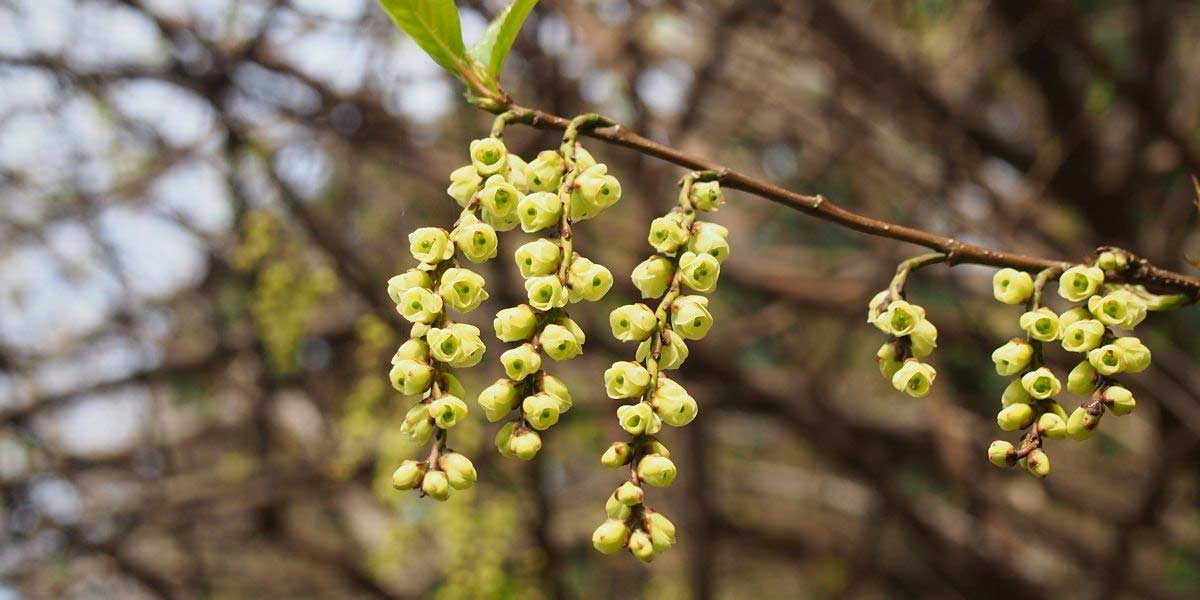
The flowering of Stachyurus praecox (photo harum.koh)
Multiplication
Stachyurus is quite easy to propagate, whether by sowing or by propagation by cuttings. We recommend propagation by cuttings, as this technique allows for quicker establishment of young plants in the garden while retaining the characteristics of the horticultural varieties.
Sowing
Sowing Stachyurus seeds takes place in autumn.
- Prepare a pot with seed compost.
- Firm and level the substrate.
- Sow the Stachyurus seeds on the surface.
- Cover them with a thin layer of compost and lightly firm down.
- Water gently.
- Then place the pot under a cold frame, in a bright location but out of direct sunlight.
Propagation by cuttings
Take semi-woody cuttings during summer, between July and September.
- Prepare a pot with a light, well-draining substrate, such as a mix of compost and sand, and water.
- Take a section of branch, detaching a small section from the branch it is inserted into (the heel). The branch should be healthy, well-formed, and free of fruit.
- Dip the base of the cutting in plant hormone to encourage root development.
- Plant the cutting in the substrate.
- Place the cutting in a humid environment by covering it with a plastic bottle or a clear plastic bag to maintain a moisture-saturated atmosphere.
- Position the pot in a bright location, away from direct sunlight.
- Ensure the substrate remains slightly moist.
Pairing ideas
Compose a stunning scene by pairing Stachyurus with other shrubs and perennials that herald the end of winter with their blooms. For example, plant it alongside Corylopsis, which also flowers at the end of winter, in similar tones. You can also combine it with witch hazel, male dogwoods, willows (for example, Salix caprea), or with Garrya elliptica, an evergreen and unique shrub that also offers a very graphic flowering, with long pendulous aments in white.
Plant bulbs and perennials that bloom at the end of winter at the base of Stachyurus. Consider, for example, Eranthis hyemalis, which provides a beautiful yellow bloom in February-March. Additionally, this ground-covering perennial naturalises easily! You can also plant garden primroses, spring snowflakes, or daffodils (for example, ‘February Gold’, which blooms very early).
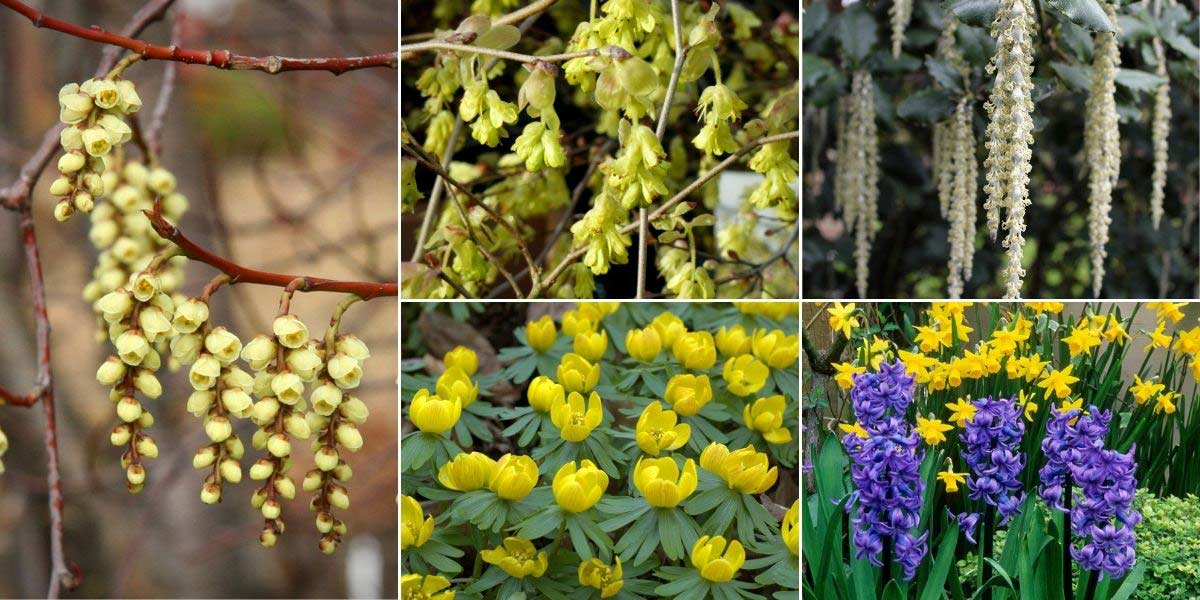
Pair Stachyurus with other shrubs, bulbs, and perennials that bloom at the end of winter or early spring! Stachyurus praecox (photo Michael Wolf), Corylopsis pauciflora, Garrya elliptica ‘James Roof’ (photo PaleCloudedWhite), Eranthis hyemalis (photo Martin Olsson), Hyacinth ‘Delft Blue’, and Narcissus ‘February Gold’ (photo Andrew Lawson – Flora Press – Biosphoto)
As it prefers acidic substrates, Stachyurus is perfect for accompanying heather soil shrubs, such as rhododendrons, azaleas, camellias, Pieris, andromedas, or Clethra.
You can use variegated Stachyurus (for example, ‘Joy Forever’) to brighten a shady corner or to create contrast with dark-leaved shrubs. Consider, for instance, purple hazels, ‘Black Lace’ elder, ‘Royal Purple’ Cotinus, ‘Black Pearl’ Loropetalum, or ‘All Black’ Physocarpus. For more options, discover our entire range of dark-leaved shrubs!
Feel free to plant Stachyurus alongside other shrubs that display beautiful autumn colours, to create a stunning scene of vibrant tones at the end of the season! It will be perfect in the company of Cercidiphyllum japonicum, Japanese maples, Liquidambar, Parrotia persica, or Euonymus alatus.
Useful resources
-
- Discover our range of Stachyurus
- To pair with Stachyurus, discover our range of winter-flowering bushes
- Our article: “Pruning bushes without stress”
- Subscribe!
- Contents
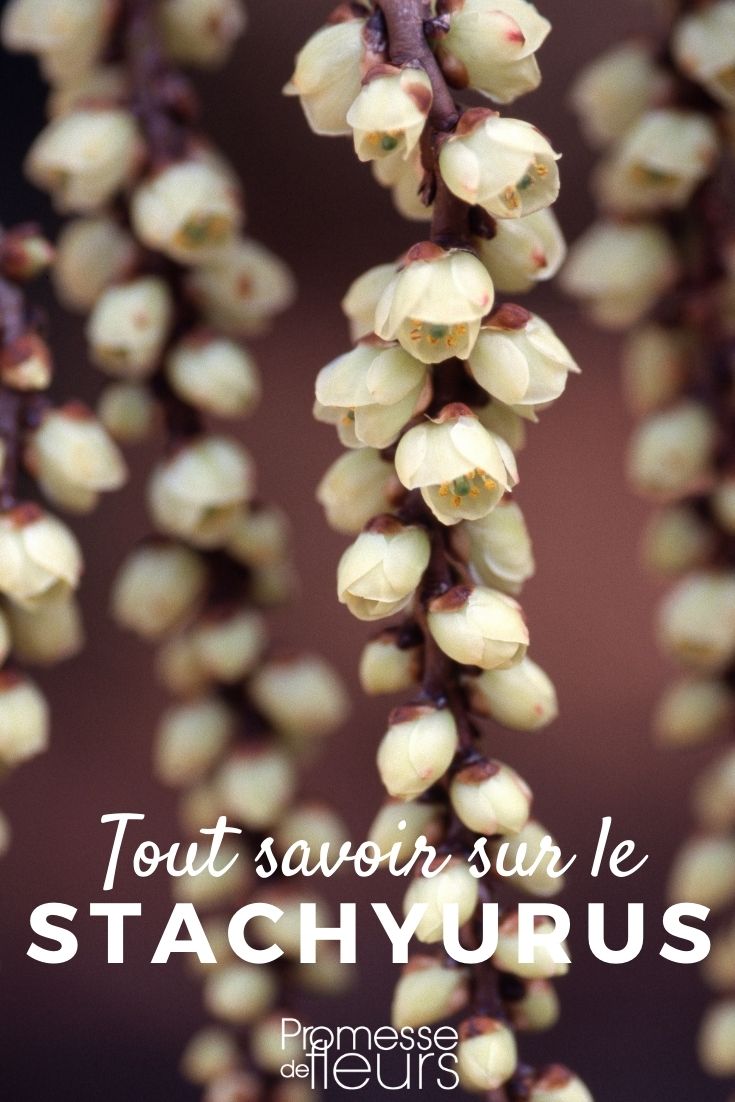


































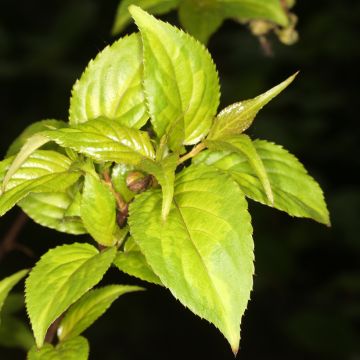
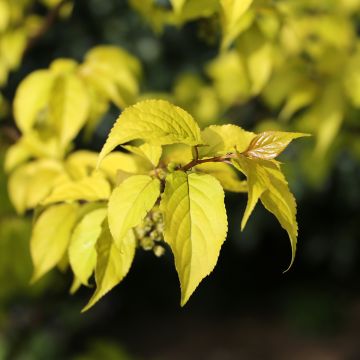

Comments